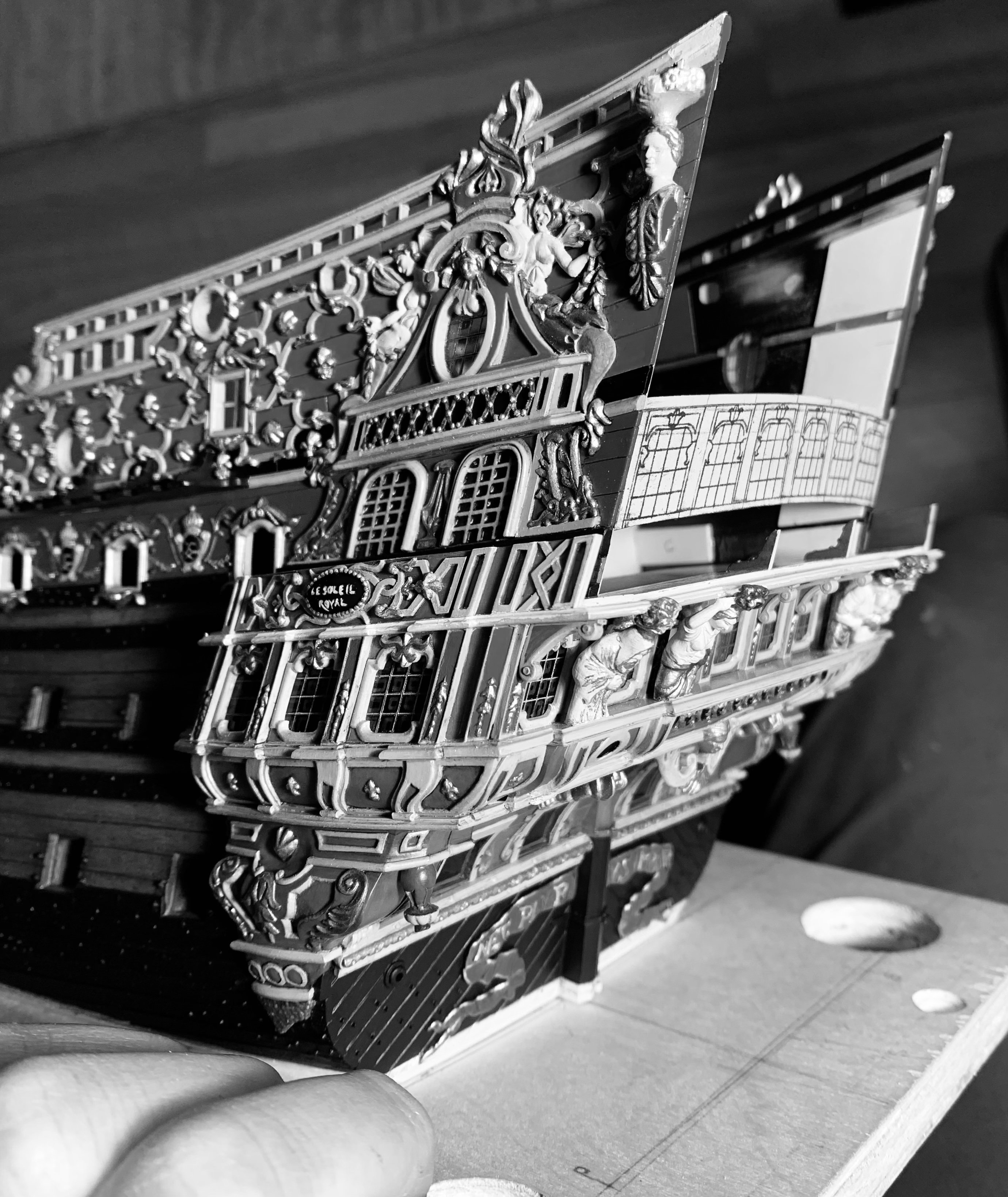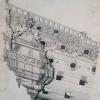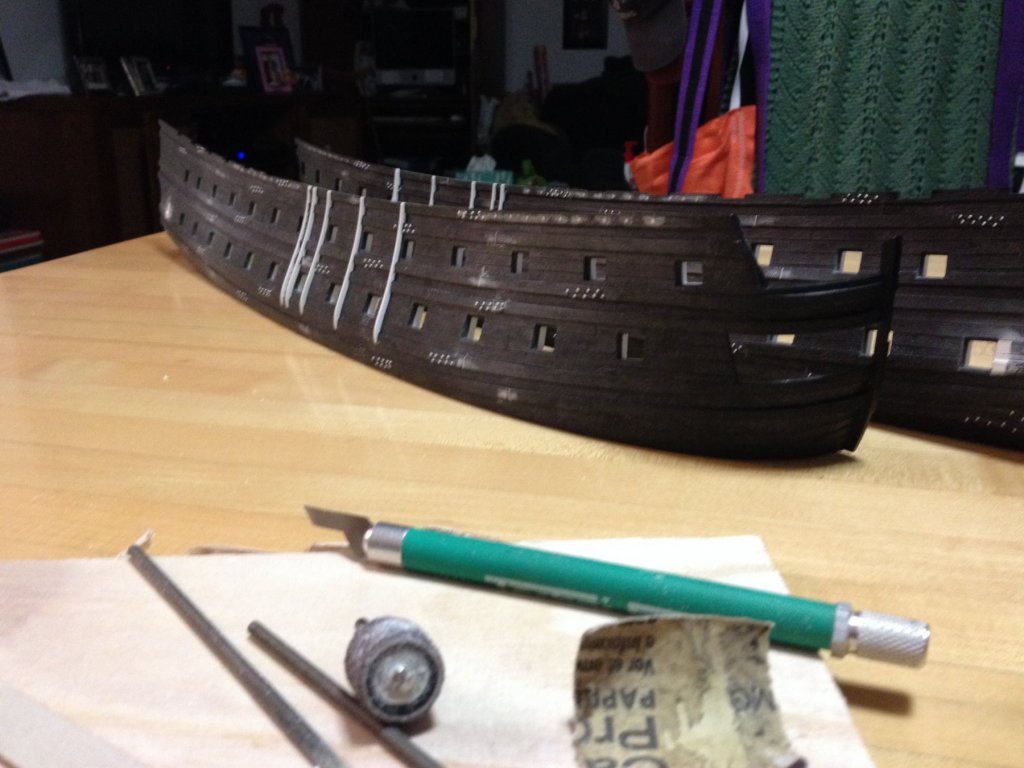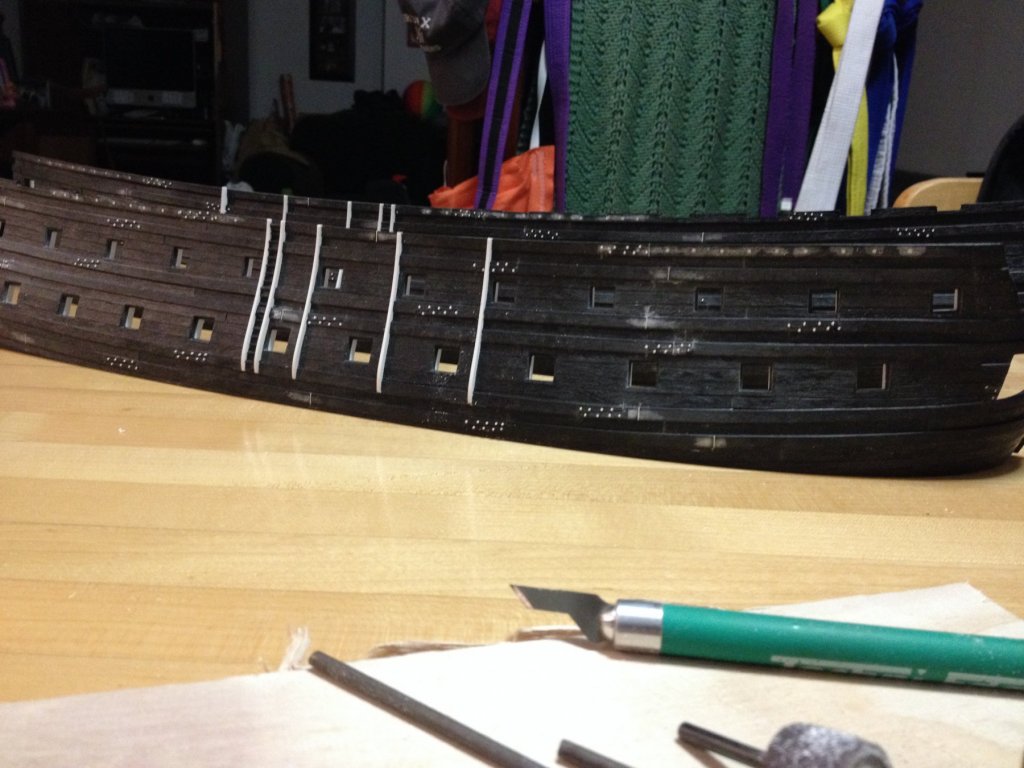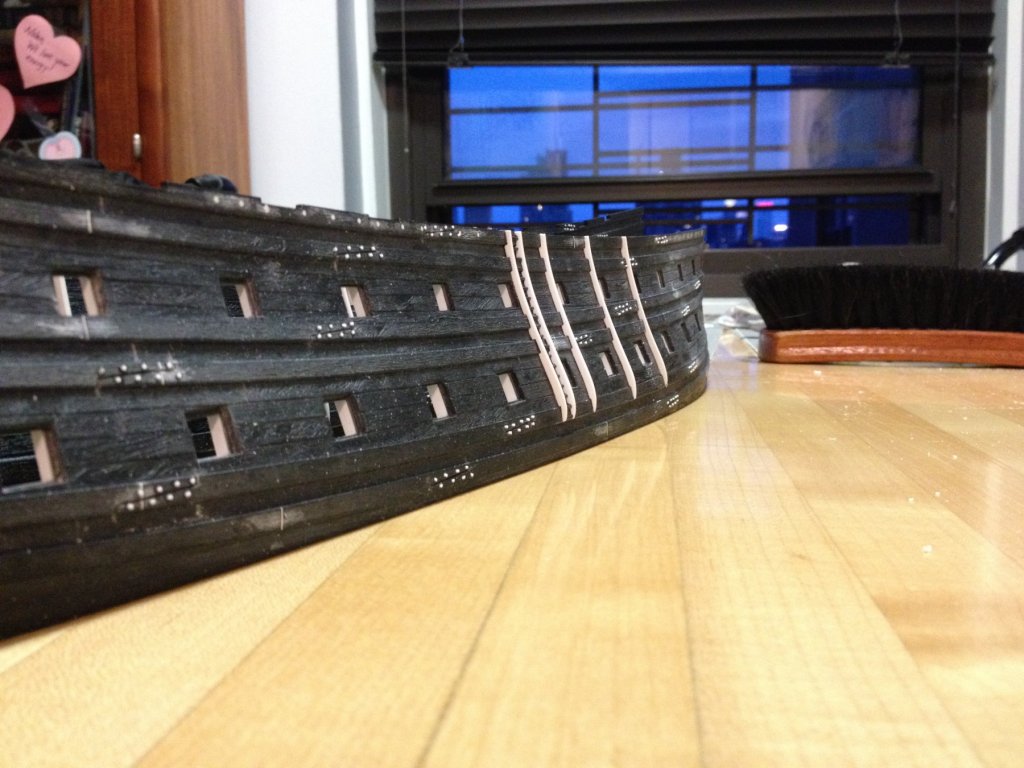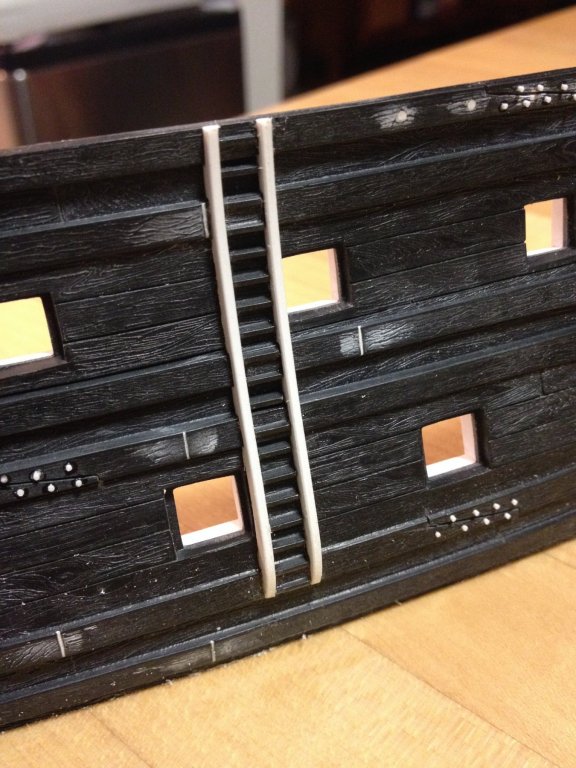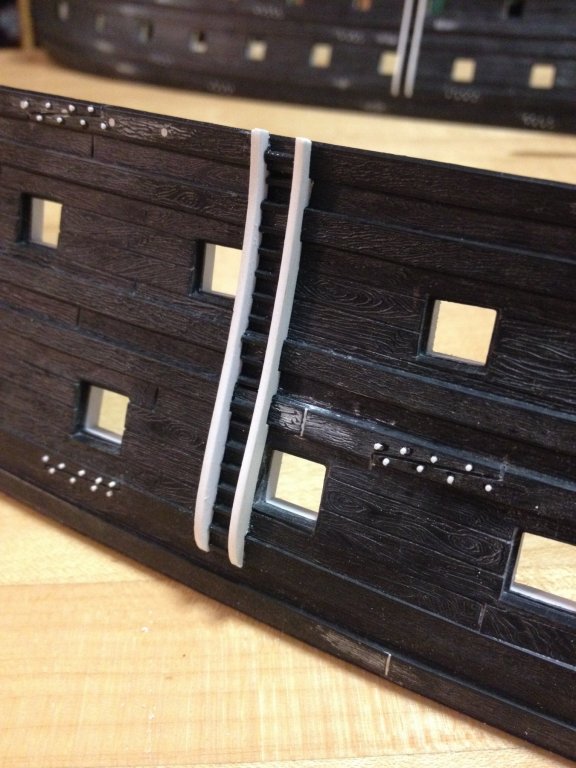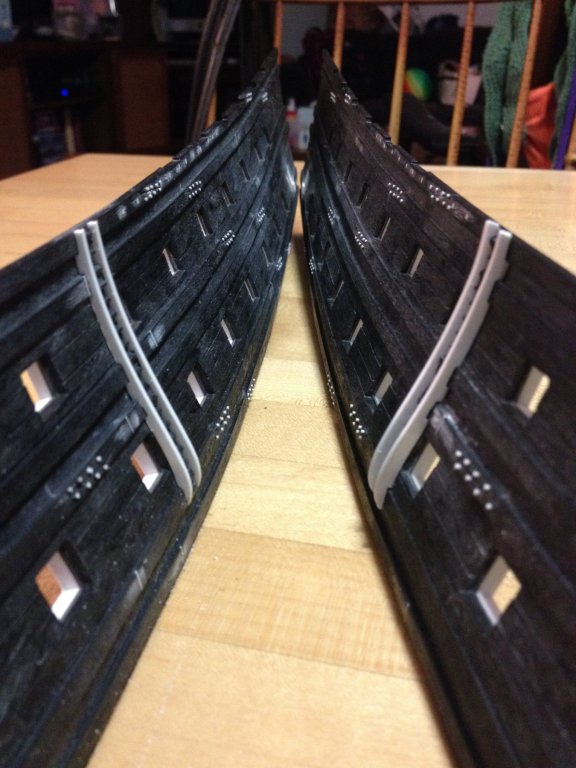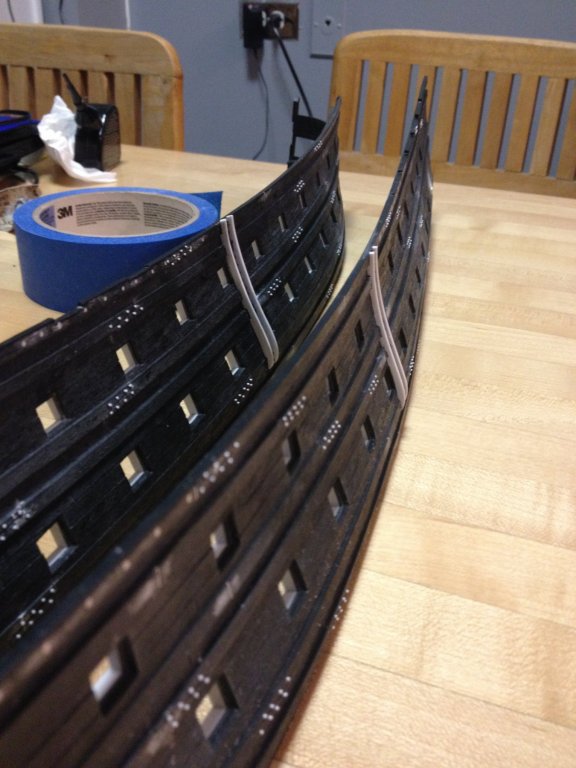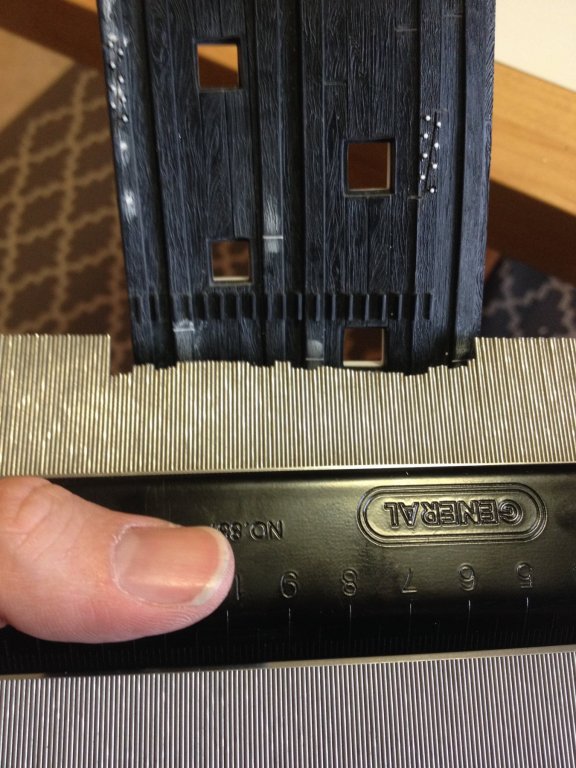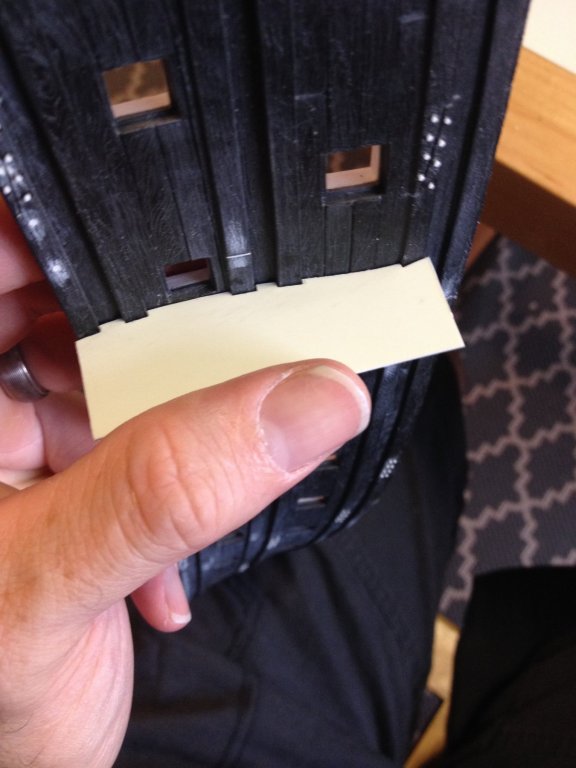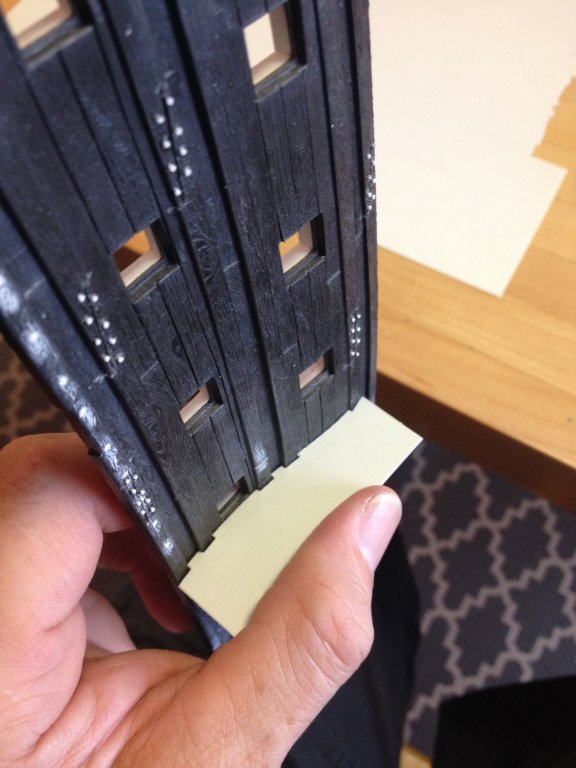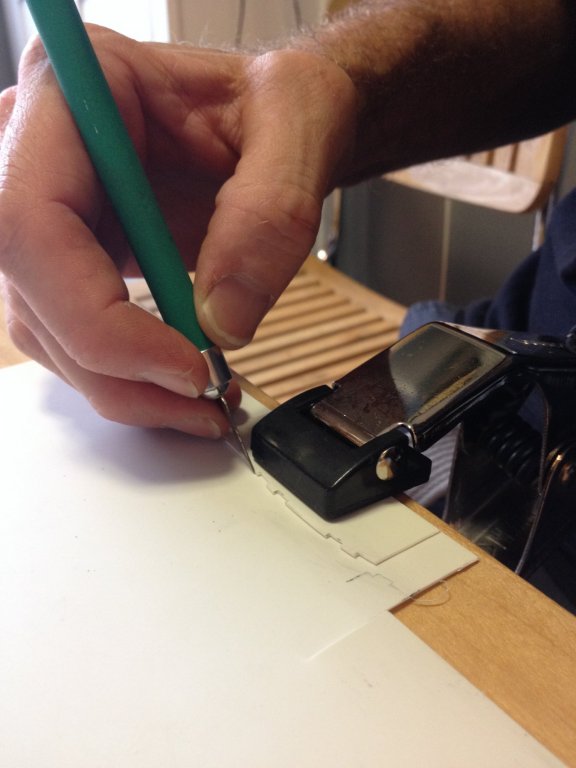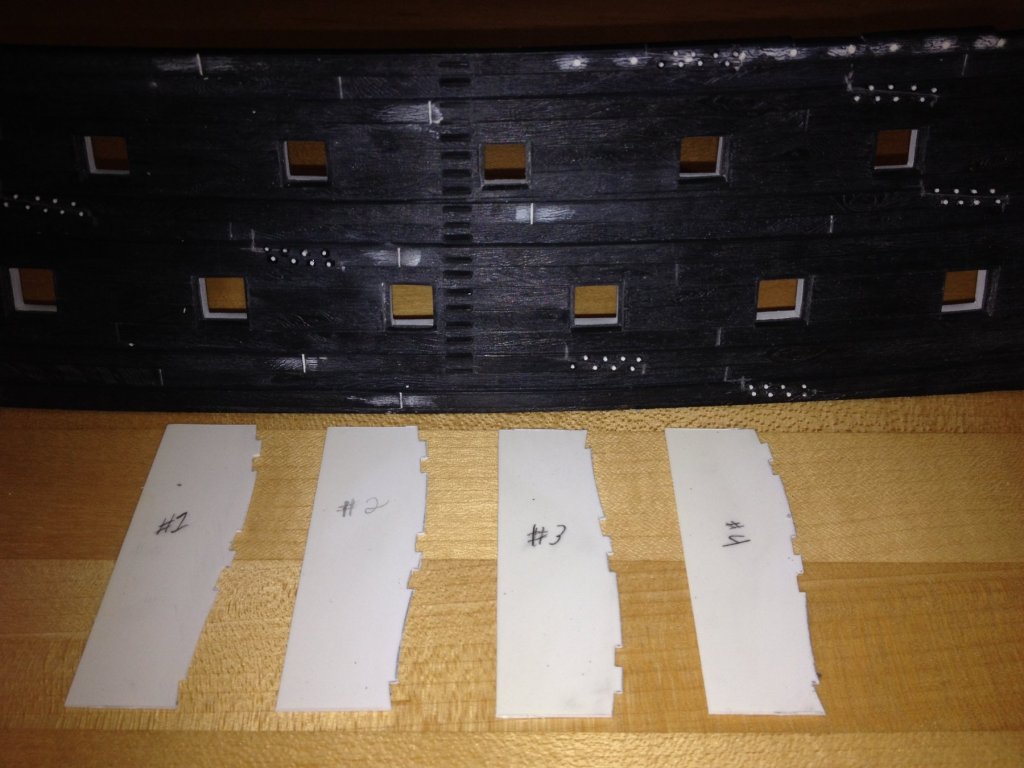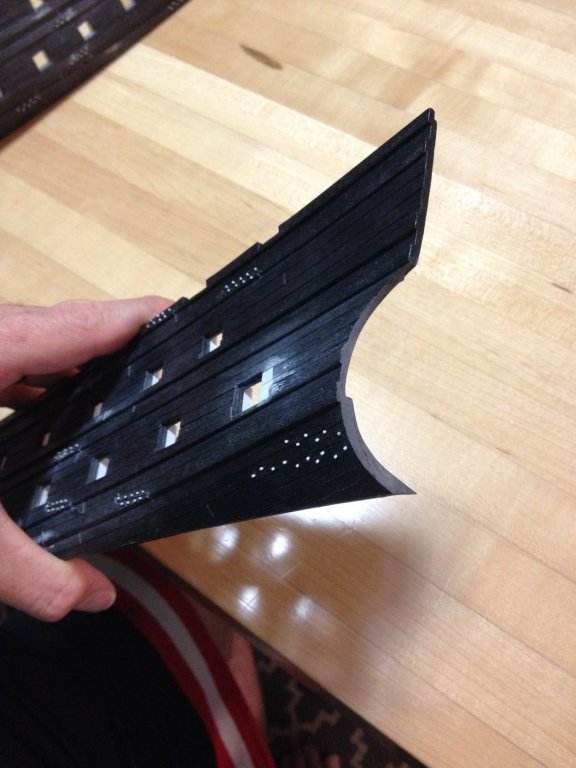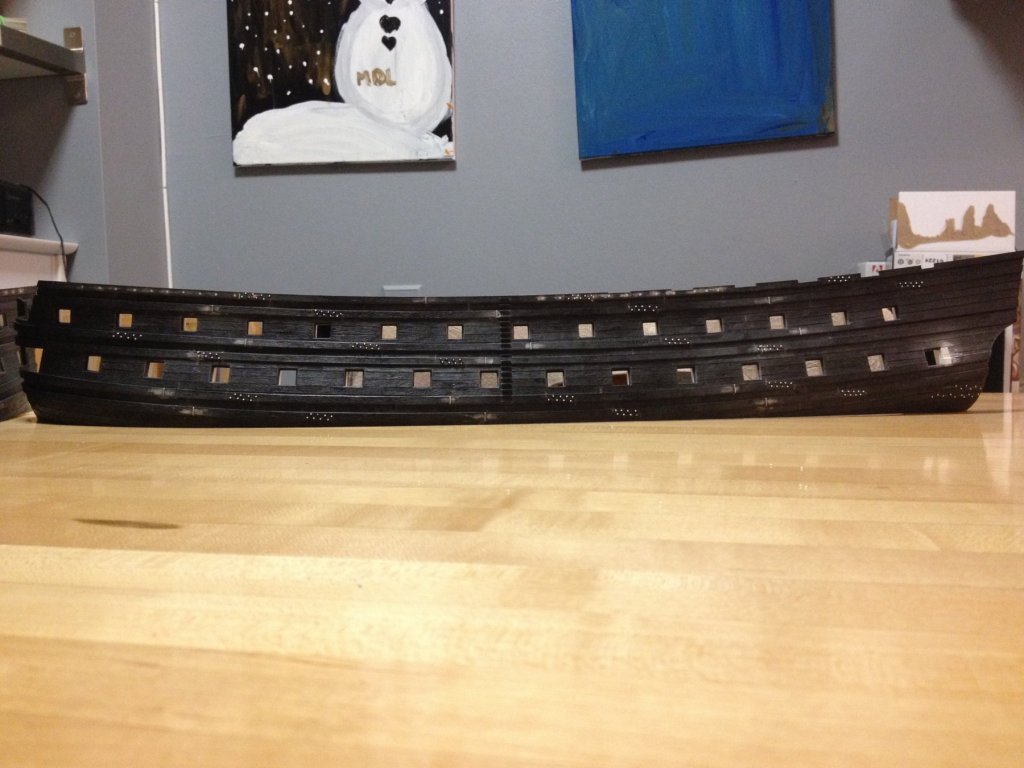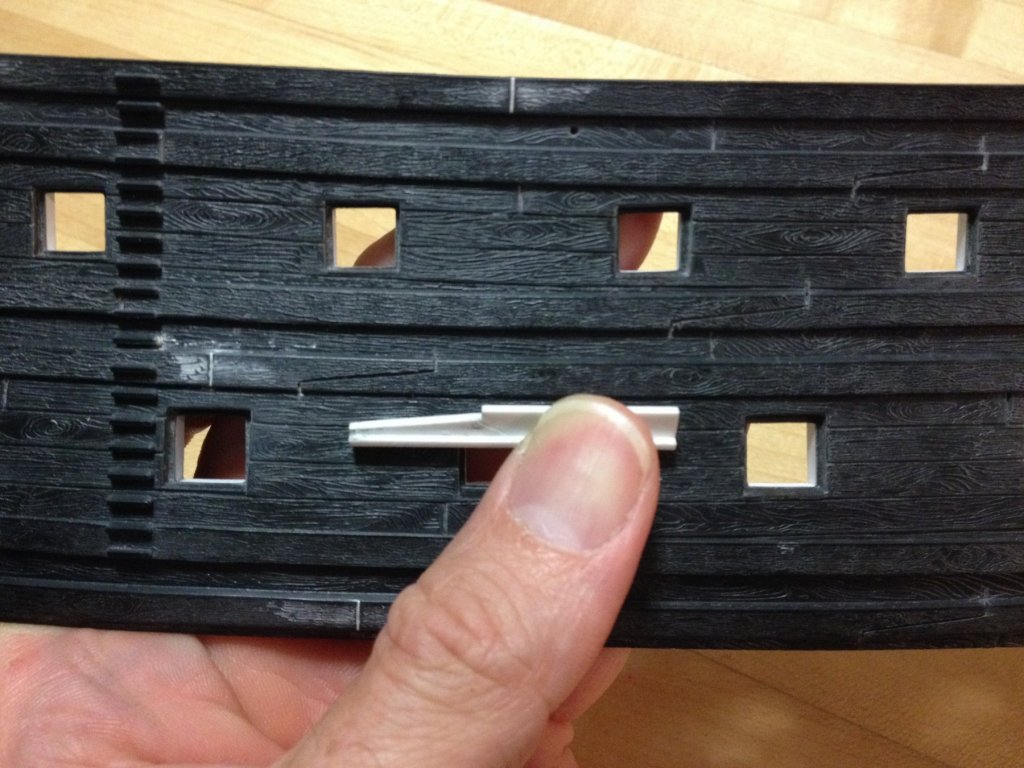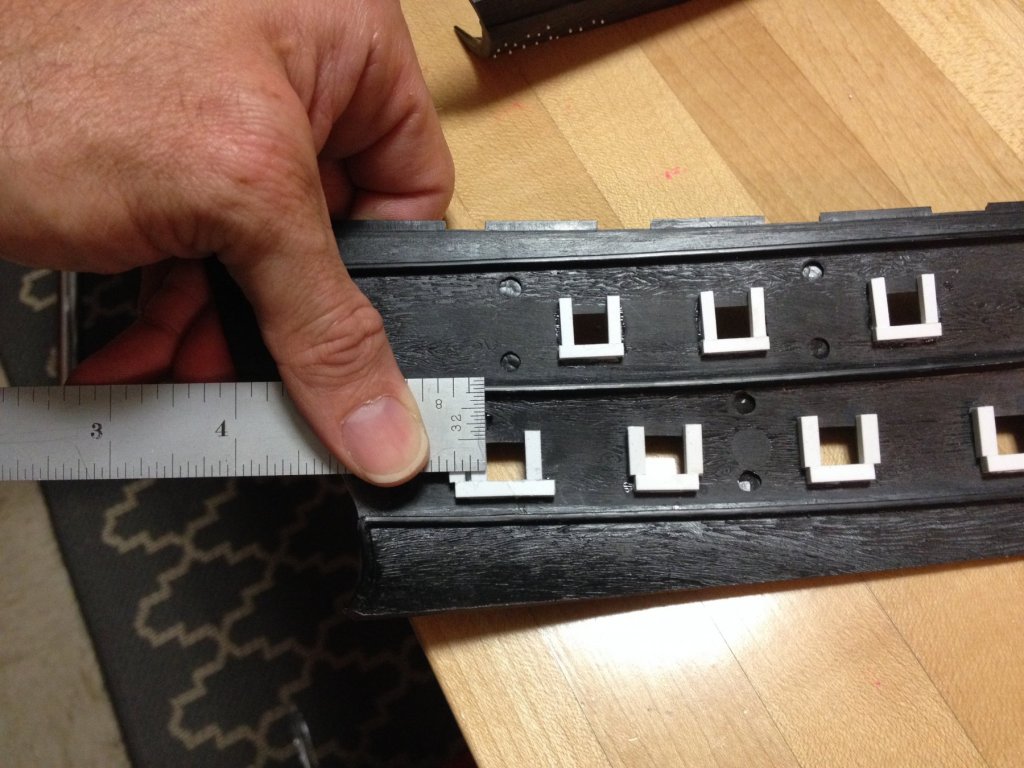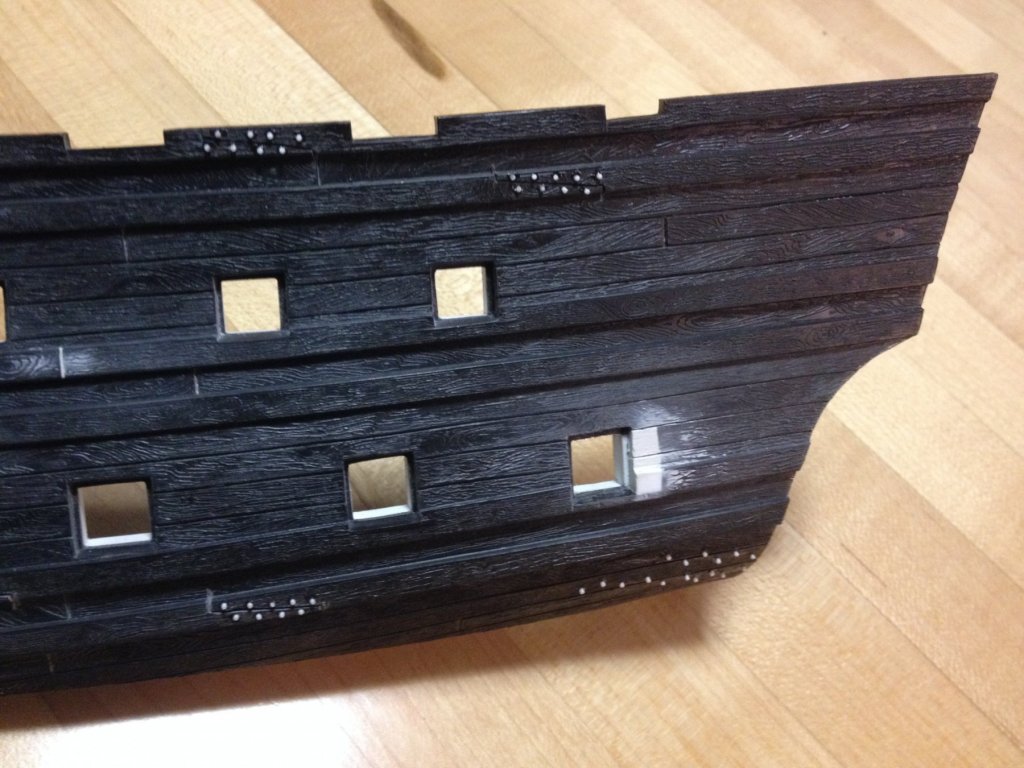-
Posts
3,295 -
Joined
-
Last visited
Content Type
Profiles
Forums
Gallery
Events
Everything posted by Hubac's Historian
-
Well, you certainly have your work cut out for you, Cedric, but your plan seems a good one to me. I realised, after the fact, that I probably should have asked you this question on your build-log for La Reyne, as people following your build would benefit from hearing your answer. I will be more sensitive to that, in the future😉
- 2,696 replies
-
- heller
- soleil royal
-
(and 9 more)
Tagged with:
-
I've been thinking about this problem you are tackling, Cedric, concerning the forward sheer of the decks. If your intention is to lower the forward sheer so that the wales forward of midships run more nearly parallel with the waterline - then all the forward wales, right up to the main deck level will need to be similarly adjusted. The trouble comes with the juncture of the lower hull with the upper bulwarks; the forward, upper bulwark will no longer fit, if you change the shape of the top, main deck wale. So, this must necessitate building new upper bulwarks from scratch, right? Or, you could adjust the run of the lower and middle deck guns/wales and leave the top sheer of the main deck wales, as it is, but I'm not sure how that would look, relative to the mIn deck guns.
- 2,696 replies
-
- heller
- soleil royal
-
(and 9 more)
Tagged with:
-
Hey Cedric! Thank you for the kind compliments! Yes, while I haven't placed the so-called "hunting ports" yet, I will represent them as closed ports that are scribed in to the plastic. I'll make up hinges and ring bolts for them. The thing about the Heller kit that I have always found perplexing is why they make separate inserts for the hawsers. I have yet to glue these in place, but when I do, I can then scribe in the hunting ports. And you're absolutely right, vis-a-vis nothing ventured nothing gained! Making my castings and extensions are what this project is all about, so that is the freedom of plastic - if it doesn't work exactly as planned, I can heat and manipulate the extension pieces to fit. I will find a way, and am really excited to experiment with making castings. Will you be posting drawings sometime soon, Cedric?
- 2,696 replies
-
- heller
- soleil royal
-
(and 9 more)
Tagged with:
-
No, EJ, I was not previously aware of that app, but it sounds perfect for the scaling of the masts and spars, among many other things.
- 2,696 replies
-
- heller
- soleil royal
-
(and 9 more)
Tagged with:
-
Oh, I'm a sinner all the way, kpnuts, but then the devil's in the details, as they say. For me, a lot of the fun is in the layering-on of detail (that the stock kit omits), until quite a different picture of the ship begins to emerge. I promise that this will not very much resemble the Heller kit, when I am through. The question is whether I will have the stamina to see it through. I think so. I'm enjoying the process, so far. Yankovich, I'm curious as to what your plan was - back when you were building this kit - to modify the shape of the bow. Were you referring to the stem and cutwater only, or were you also considering a fundamental change to the shape of the hull? Do any pictures survive of this model?
- 2,696 replies
-
- heller
- soleil royal
-
(and 9 more)
Tagged with:
-
Hey EJ, thank you for the compliment! I understand what you are saying about the switch-back companionway. Interestingly, this seems to be a feature most often seen on English ships, even large first-rates, and often terminating in a middle-deck entry port. From what I've been able to ascertain about French practice, the companionway ladder was most often a straight-forward, straight up and down affair, much like their simple, un-adorned ladders from one deck level to the next. The scale of the Heller kit is 1:100, which makes the math a little easier for the sake of scaling the scratch-built elements of the build. So far, though, I have mostly gone by my eye, for scale. Just as you are debating whether to through-bolt the wales, I was debating whether to continuously bolt the wales between scarfs. Often, modelers seem to use some form of domed pin to represent the bolts. My thinking is that, unless the scale is sufficiently large, this rarely looks convincing. I had an idea, though, that I could cut very small slivers of the same styrene rod that I used for the through-bolting, and then flash them with a wand lighter, over a piece of tin-foil. When I tried this, the result was perfectly domed little "bolt-heads" that had perfectly flat glue surfaces and that would look good in-scale, on the model. Unfortunately, unlike Dan Pariser's excellent advice for simplifying and speeding up the through-bolting process, there will be no short-cuts for this particular detailing; toothpick, dot of glue, place domed bolt head in place with the tip of a knife. Helle-tedious, but the addition to the model will contribute greatly to the overall impression. I think, for your build EJ, the Arsenal modeling sites are an invaluable resource for the craft work that produces convincing results, no matter what the scale may be. In particular, there are the models of Michel Saunier whom you are familiar with, and Nek0 (also name Marc) whom you may be less familiar with. Both are friends and have collaborated to create two differing interpretations of the ship that are applied to the same essential architecture. In my opinion, these two are the best combined resources for contemporary research on SR. They are also the two best and most ambitious models of the ship that I have yet to find. Although, there is one really good model made by a Danish man that displays excellent craft and pleasing proportions. I'm excited for your model, EJ, because the fun work of the stern is not that far off in the future for you!
- 2,696 replies
-
- heller
- soleil royal
-
(and 9 more)
Tagged with:
-
Thank you, Yankovich! I also read that Victory build log. I'm not sure I will go that route, with sanding down the grain lines, which are pronounced; only, I suppose, if they are too patchy next to areas where I used a coarse abrasive pad to level filler. And, yes, there is certainly a lot of passion for the subject involved, here. I'm not sure whether the key modifications I have in mind are going to work - the ones where I broaden the hull by 1/2", and extend the stern by 3/8". If they don't, then I suppose this will be a glorious failure and I'll have to go All-In on a full scratch-build. I remain cautiously optimistic, though, that I can pull it off and present a reasonable facsimile of what I think this ship once was.
- 2,696 replies
-
- heller
- soleil royal
-
(and 9 more)
Tagged with:
-
Skids installed! Next up - I may return to the wales, which still need to be bolted along their length.
- 2,696 replies
-
- heller
- soleil royal
-
(and 9 more)
Tagged with:
-
Ken, I am always reading along, if not always commenting, because I find myself wanting to say the same thing over and over. Still, your work warrants mentioning one more time: Wow! What crisp and beautiful results you are getting through a variety of resourceful solutions to tricky construction problems. Great work, Ken!
- 424 replies
-
Terrific shaping on those headrails, Michel. It would seem that the figurehead angel will be added to the seahorse as a separate ornament, and then the scrolls of the headrails will nestle behind the angel's wings. What is your plan for attaching all parts to each other: pins and epoxy, or just glue of some sort?
-
Thank you, Cedric for your kind words and birthday wishes. 44, strong! And thank you, as always, to everyone who stops in, for following along with your likes and comments. It is tremendously motivating! Cedric, I can appreciate how you are feeling about La Reyne, right now. We are engaged in a marathon, as opposed to a sprint. I sincerely hope you won't lose your motivation to push through and keep going. Personally, I derive so much inspiration from what you are doing. The sheer ambition of your project, combined with the excellent early returns on your work really keep me chugging along - even if all I have to show for an evening is a part roughly shaped, or a few more lines on the computer screen. Keep going, my friend! What you are attempting will make my build seem like child's play but we will all be the richer for following along.😉
- 2,696 replies
-
- heller
- soleil royal
-
(and 9 more)
Tagged with:
-
The first set of skids I patterned were the ones that frame the waist ladder. I left the outboard profile oversize in order to make extra allowance for fitting close to the hull, but also because the parts, themselves, can be a little fiddly and difficult to handle if they are too thin. Here's a pic of a set installed, but before thinning to final shape: While the outboard profile follows the tumblehome nicely, the steps appear set back too far, and the overall impression is that the skid timbers are too heavy. Here's a shot after fairing the skid timbers closer to the hull: Now the treads are more visible, yet still protected by the skids. There are a few spots where a skid saddles a wale, where a spot of filler is needed, but the inletting was pretty close, overall. Here are a couple of side by side pics for the sake of comparison: Next, I'll pattern three more skids per side, following the same process and to the same proportions.
- 2,696 replies
-
- heller
- soleil royal
-
(and 9 more)
Tagged with:
-
I feel similarly daunted by creating the ornaments from scratch. What has given me some re-assurance, though, was watching a series of videos by Doris (the spectacularly talented card modeler) on her Royal Caroline build-log. I would never suggest it's easy, but these are definitely attainable skills for modeling polymerized clay. Because she takes you from start to finish on a relatively complex figure, one gets a strong sense for how she evolves the work from a roughly proportioned shape to one with shape and definition, using only about four simple tools.
- 961 replies
-
Okay, now that I'm viewing the site on my desktop, as opposed to my phone, I can see that there are likes visible on the most recent entries to my build log, however, they have mysteriously disappeared from prior posts. Not a big deal, either way, just a curious thing.
- 608 replies
-
- la couronne
- corel
-
(and 1 more)
Tagged with:
-
Where, specifically, are you finding that, Yankovich?
- 608 replies
-
- la couronne
- corel
-
(and 1 more)
Tagged with:
-
You can, but just not within the post. Or, at least, that's what appears to me when I visit other build logs, as well as my own. The like button activates, when you press it, to indicate that you have liked the post, but you can't see who else did, particularly while in someone else's build log. In the past, I might browse through logs and eventually follow them when I see that those logs are attracting modelers whom I admire, or with whom I share modeling interests. To me, it was sort of like the way Pandora finds music for you; "if you like this, then try this..."
- 608 replies
-
- la couronne
- corel
-
(and 1 more)
Tagged with:
-
Just surfing along ona slow day... Great looking model, Don! Beautiful detailing throughout, and your ship's boat is a model within the model. Really excellent work!
- 653 replies
-
- trabakul
- marisstella
-
(and 1 more)
Tagged with:
-
With the scarfs through-bolted, I decided to turn my attention to the skids of the waist - beginning by framing in the gangway steps. In my most recent drawing, I show the gangway steps moved one gunport aft because I thought it made for a more balanced appearance with the three skids forward of the ladder. I have decided, though, that this is an unnecessary modification because the spacing of skids, relative to the ladder, is often shown to be irregular in many of the VDV portraits I've seen. Added to that fact is the strong possibility that moving the ladder aft may hinder my ideal placement of the main channel. so, recently I picked up one of these scribe guages for exactly this sort of patterning application: it only seems to work well, if you push the guage square into the hull - as though parallell with the imaginary vertical plane, running down the center line of the ship. Then, I simply transfer the shape of the tumblehome and the wale locations to a sheet of .020 sheet styrene, which is thin enough to cut with scissors. I refine the shape with sandpaper around a large dowel and needle files for the areas that saddle a wale, until the pattern fits snuggly: Then, I tried the pattern in the forward edge of the ladder on the same side, as well as the fore and aft locations on the starboard side. I can see that with small, additional adjustments, this one pattern will suffice for all of the ladder framing skids. I then transferred the pattern three more times to the .020 styrene sheet, and then cleaned and refined to my scribe lines: The next step will be to use that same guage profile to establish the outside curve and depth of each skid, which will be slightly oversize and transfered lightly to each of these .020 patterns. I will then laminate these thin patterns to sections of .032 styrene sheet to make up the desired thickness of each skid member. I can then waste away most of the excess with sheet metal snips and get close to my lines with the Dremmel before refining and hand-fitting each skid in place. the ladder rungs, themselves have rounded ends, which I will cut square, in order to make a good joint with each vertical framing member. I will repeat this process for each different skid location moving forward. I should also mention that each of these skids extends into the upper bulwarks. I've decided to construct them in a lower and upper section that will be faired together, later on, in the construction process. The reason for this is that I want a solid plastic to plastic bond before painting of the lower hull. It will be a relatively simple thing to line up and glue in the skid extensions to the upper bulwarks.
- 2,696 replies
-
- heller
- soleil royal
-
(and 9 more)
Tagged with:
-
I suppose they did this to de-clutter the page. I'm not a fan of the change, though. While it's true that you can still see your likes and from whom, it isn't always clear what a person is "liking." You can extrapolate that they are responding to your recent posts, but they may be responding to any given post throughout the thread. What I liked about the old format was that, even if someone wasn't commenting, you could see at a glance who else was viewing the thread.
- 608 replies
-
- la couronne
- corel
-
(and 1 more)
Tagged with:
-
I've just been experimenting with Dan's suggestion for the through bolting, and it really works like a charm! There is no excess glue and you can emmory board them to height immediately. Huge time saver and now the carriage tackles seem like an actually pleasant job. Thanks again, Dan!
- 2,696 replies
-
- heller
- soleil royal
-
(and 9 more)
Tagged with:
-
I appreciate that, Dan! The scarfs are a small thing, but a vast improvement to the impression the model makes. I really like your idea for simplifying the bolting. The Dremmel Micro is light enough that I should be able to control the drill bit, but again, I can experiment on my scrapped lower hull halves. Also, your idea about the mechanical pencil, I think, is the way to go. I imagine I would pencil in the treenails after the main colors go down, but before the wash coat for light distressing. I think I would then need to spray some form of clear matte coating to seal them in, before going over that with a semi-opaque acrylic wash. I also appreciate the digital camera offer. I have a really good camera at home, but I often take my blog pics with the phone because then they are in the phone and I can create these posts, during my breaks, at work. For this and several other good reasons, the time has come, really, for me to upgrade my phone. There's also the single-handed ease of holding the phone and positioning the model in better light with the other hand. What I could also stand to upgrade is the overhead lighting in my kitchen 😉
- 2,696 replies
-
- heller
- soleil royal
-
(and 9 more)
Tagged with:
-
The other thing I need to do, at this early stage, is re-shape the lower transom, in order to incorporate the round-up of the stern. I apologize for the lack of in-process photos that would paint a clearer picture of what I'm actually doing. My Iphone 4 😔 runs out of storage quickly, so I sometimes have to choose between clearing the phone or making progress on the model. Anyway, what you are seeing here is the profile of the lower transom which has been reduced, inboard, by a heavy 1/16" and faired into the arc of the stern counter, so that it is now flush with the kit's glue surface support for the transom piece. As I get closer to mounting the hull halves to their new styrene base, I will shave away this old mounting surface and recess the new one by the thickness of my transom planking. Also visible, here, are the through bolts for the transom supporting knees (not sure what the propper name is for these interior timbers), which will eventually be scraped away, in part, where they interfere with the lower finishing; that is to say - not much. My process for the through-bolting is something I learned from Herbert Thomesan. All I do is take a single-edge razor to .020 styrene rod and - as square as my eye can tell - I shave off a hundred, or so, slivers that are not much bigger or smaller than 1/32". I, then, sharpen the tip of a toothpick with which I can set a small dot of Testors liquid adhesive directly to the hull. Then, with the very point of the Exacto, I pick up a reasonably square-cut looking sliver, on it's end, and place it onto the glue dot. Hold for five seconds, and then repeat. Despite wearing glasses, my eyes are still good enough for this close work, but I am meaning to purchase the type of magnifying LED visor that Dan Pariser showed me, recently. It takes a little practice, but once you have the hang of it, this moves along at a pretty good clip. At pace, I can do just under half a hull half in a session before I get too tired to continue. After I finish bolting the starboard wales, I'll take a little break from that particular tedium, and I'll pattern skids for the waist. Then I'll move on to the anchor sweep planking at the bows, scribing in the "hunting port," and making the lower and middle deck scuppers. After that I'll tackle the truly tedious task of washer/through-bolting all the carriage tackles at each gun port. And after that - I will move onto some form of simulated tree-nailing; I'm thinking the blunted tip of a pin, slightly heated, in a pin-vise. Here, it is usefull to have saved the lower hulls for conducting my experiments.
- 2,696 replies
-
- heller
- soleil royal
-
(and 9 more)
Tagged with:
-
In order to cut in the forward half of the new port, I first layed out both the inner lip and the cut-back edge of the "planking" with a sharp pencil. Once I liked the looks of that, and could see that it was a level continuation of the port, I then scribed in those lines with the Exacto. Next, I took my new Dremmel Micro with a narrow, diamond crusted shaft, and wasted away everything within the inner lip lines. With needle files, I was then able to define the inner corners and fair to the scribe lines. Next, I fitted the micro with a straight-sided cutting bit that has no tooth on the bottom surface. I used this bit to cut the planking back from the lip until I was approximately close to my line and as far as the bit would allow into the corners. I now had a very roughly thicknessed lip in the black plastic of the kit. To clean up and define these edges, I used an 1/8" woodworking chisel for the corners and to scrape back the lip to a matching thickness, as well as a 1/4" chisel to trim the planking to my lines, making light passes and using a gentle wriggling motion. Despite my care in doing these things, there were two small mishaps. First, while using the straight cutting bit to rough back the planking, I dug too deep, the bit then grabbed and jumped out of the cut. In the process, I nicked a decent chunk out of my new, aft port stile. No problem: a touch of Squadron and the emmory board, and it was good as new. I have noticed this tendency of Dremmel bits to grab and jump, in wood, if the speed and depth of cut are off, but I wasn't expecting that in plastic. Lesson learned. Then with the 1/4" chisel, I pushed too hard, at one point, and sheered off the top lip of one port frame. No problem: I cut a small strip of sheet styrene, of the appropriate thickness and glued it in place. Once it is painted, one will never know the difference. The ease of repairs is what I like about plastic. Those same mistakes, in wood, would be much more labor intensive to repair because you can't hide the repair under putty and paint. To a large degree, in small scales, wood really determines your choice of tools and methods, so that you run the least risk of these mistakes. To finish off the interior framing, it was necessary to extend the sill, with a simple angled scarf joint, and then fit and glue in a new forward stile.
- 2,696 replies
-
- heller
- soleil royal
-
(and 9 more)
Tagged with:
-
So, as I mentioned in the prior post, my drawing process has stalled, and I don't have any good answers as to why, right now, so I've decided to go ahead and begin detailing the lower hull halves. I will shift my focus back to the drawing, at some point, because I really need a good scale drawing for all of the ornamental work of the stern. For now, though, the change of pace is welcome. The first thing I wanted to do was to fill in all the butt joints on the wales and the eyelet holes for the chain plates because butt joints would never have sufficed for that application and I'm lowering the channels to the wale strake where these holes currently exist. I'm using Squadron white putty. Shrinkage seems minimal, it sets and hardens fairly quickly and it works easily with sandpaper, emmory board, or a knife. For this particular application, though, I have found that maroon abrasive pads do an excellent job of levelling the putty, without completely erasing the moulded, raised grain effect that the putty inevitably covers, upon application. The grain softens a bit, compared with un-abraded surfaces, but it should still show through the paint without the difference seeming jarring. If I think it all appears too patchy, under primer, then I'll soften the rest of the grain later. Here, you can see a few examples of the filled and leveled butt joints, as well as the simple, reversable jig I made to mark out scribe lines for my new scarf joints. To cut them, I lightly drag the tip of an Exacto blade (#11 works) backwards, and against the pattern a few times. Once a faint line is apparent, I use increasing pressure on the backward stroke to engrave the plastic to the width of the blade. I found it helpfull to establish the vertical stop cuts, first, and then to drag the knife from the stopcut, towards center of the scarf, in each direction. Once I had a rhythm going, it moved fairly quickly; I averaged one half of a hull half in a session. The next challenge was a little daunting, at first. I wanted to move the aft-most gun port of the lower battery forward by 3/16", in order to allow a clear space for the full lower finishing of the quarter gallery. To begin, I inserted a new framing member (1/8x1/8" styrene, mostly obscured by the steel ruler) on the inside face, and 3/16" forward of the aft port stile. Note: this is an after the process photo, which also shows the re-located forward port stile; in reality, though, this second new stile doesn't come until later. So, with a new ledge, onto which I can now glue small fitted pieces of sheet styrene, I began to fill-in the aft 3/16", on the outside face of the port. The first layer of sheet styrene was the same thickness as the interior lip of the stock gun port. This, I glued flush with the edge of the new aft framing member. The second layer of sheet styrene was very nearly the thickness of the kit "planking." The difference was less than a 1/64", which was easily filled with Squadron white, and leveled with a coarse emmory board (which provides some grain texturing) and a knife. Also at this time, and before applying putty, I built out the missing bit of aft wale section with strip styrene. I then scribed back-in the missing plank lines: On break, I'll continue this post to describe the cutting in and framing of the forward half of the new port, as well as the through-bolting of the wales and the transom knees.
- 2,696 replies
-
- heller
- soleil royal
-
(and 9 more)
Tagged with:
About us
Modelshipworld - Advancing Ship Modeling through Research
SSL Secured
Your security is important for us so this Website is SSL-Secured
NRG Mailing Address
Nautical Research Guild
237 South Lincoln Street
Westmont IL, 60559-1917
Model Ship World ® and the MSW logo are Registered Trademarks, and belong to the Nautical Research Guild (United States Patent and Trademark Office: No. 6,929,264 & No. 6,929,274, registered Dec. 20, 2022)
Helpful Links
About the NRG
If you enjoy building ship models that are historically accurate as well as beautiful, then The Nautical Research Guild (NRG) is just right for you.
The Guild is a non-profit educational organization whose mission is to “Advance Ship Modeling Through Research”. We provide support to our members in their efforts to raise the quality of their model ships.
The Nautical Research Guild has published our world-renowned quarterly magazine, The Nautical Research Journal, since 1955. The pages of the Journal are full of articles by accomplished ship modelers who show you how they create those exquisite details on their models, and by maritime historians who show you the correct details to build. The Journal is available in both print and digital editions. Go to the NRG web site (www.thenrg.org) to download a complimentary digital copy of the Journal. The NRG also publishes plan sets, books and compilations of back issues of the Journal and the former Ships in Scale and Model Ship Builder magazines.

